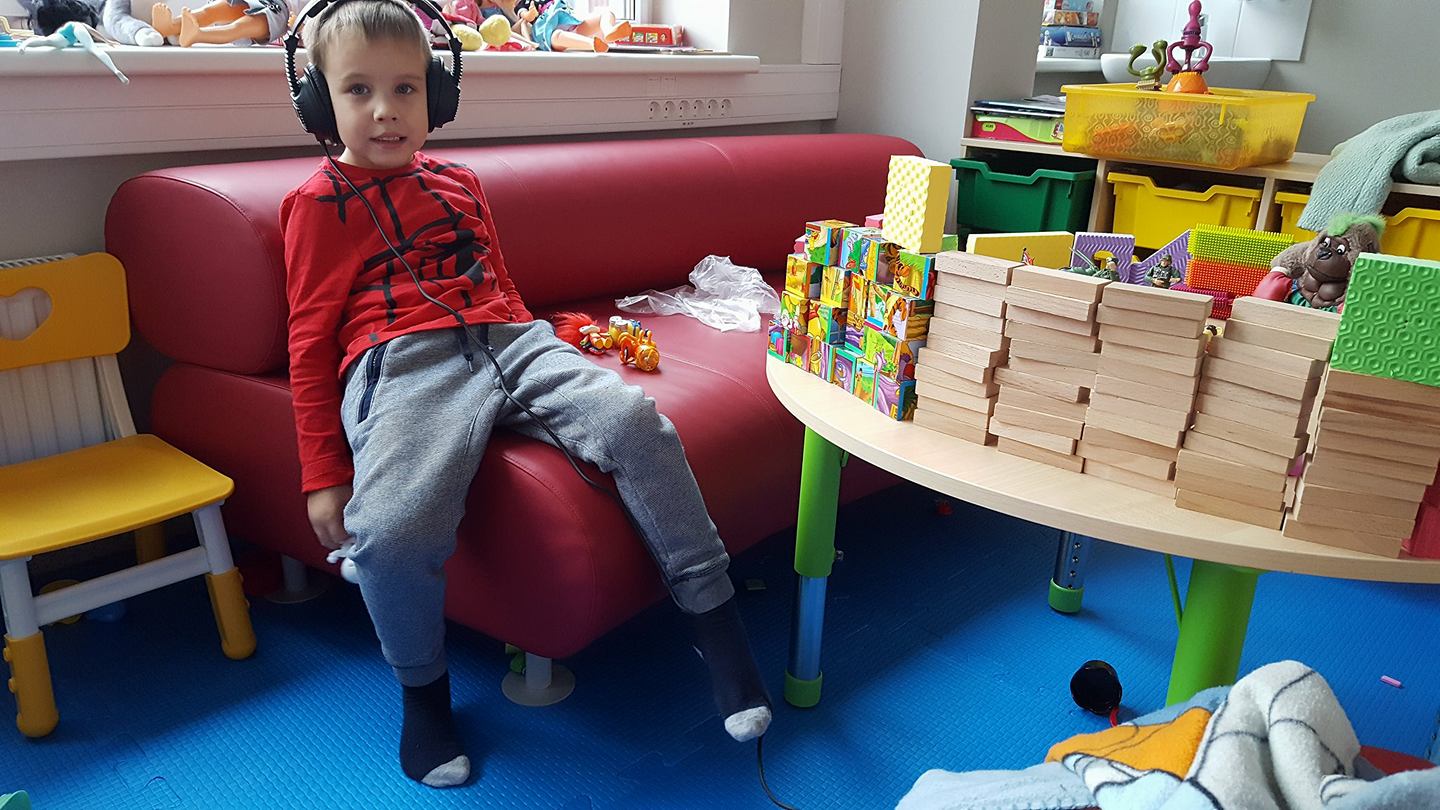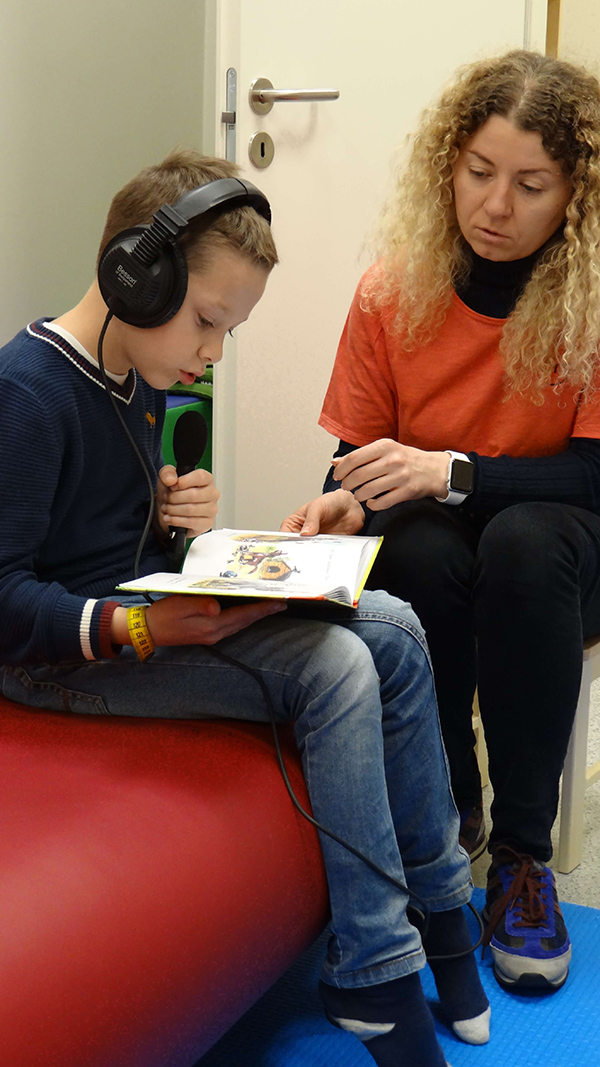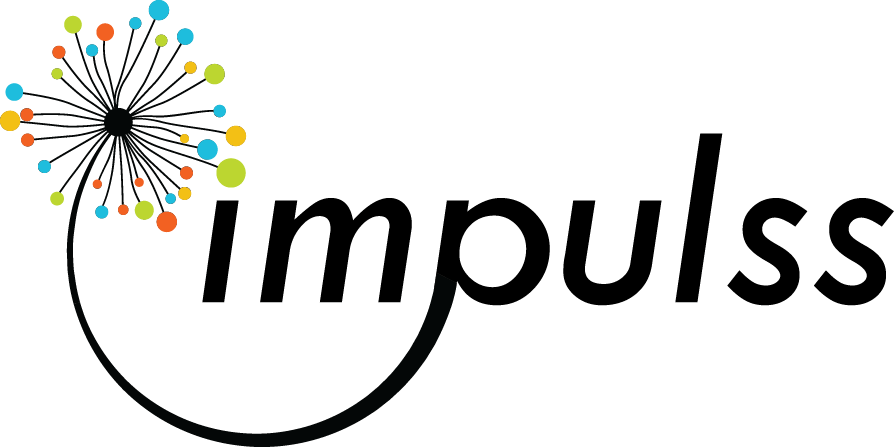What is this?
Hearing exercises that are used to develop hearing sensations. The method was developed by a French doctor Alfred Tomatis in the beginning of the 1950s. Alfred Tomatis discerned two processes: passive, i.e. hearing, and active, i.e. sensing the necessary auditory information and filtering out the unnecessary.
Hearing exercises developed by the Tomatis method are aimed at teaching the brain to perceive auditory information more effectively, better organised and more balanced. The sessions are prescribed to children with disorders in oral and written speech, attention disorders or disorders of the autistic spectrum. These exercises are not only used to work with children. For example, opera singers also make use of this method, as it helps to improve their vocal capabilities. It is also used by adults for studying foreign languages.
What problems does this help to solve?
Some children have difficulty in perceiving higher frequency sounds. Because the child cannot clearly hear many consonant sounds, the development of its own speech is violated. Another issue is that not all children are able to perceive speech with a background noise, like in a classroom. Sometimes a child seems inattentive because its brain is unable to separate necessary auditory information from the secondary information.

There are children that primarily hear with their right ear, there are those that primarily use their left ear. The right ear is connected to the left hemisphere of the brain, where the areas responsible for speech development are located. If a child primarily uses its left ear, then the information is first received in the right hemisphere of the brain and then it gets sent into the left hemisphere, which takes more time. Moreover, the sounds can be distorted on their way to the left hemisphere, especially high frequency sounds. This complicates comprehension of what is heard.
With the help of training and exercises the right ear can be made dominant. This discovery made by A. Tomatis became widely used and registered as “The Tomatis Effect” at the French Academy of Science and Medicine.
How are the sessions conducted?

First the hearing abilities of the child are assessed using specialised equipment and an individual program is designed. The hearing abilities get assessed at the middle and at the end of each course.
Method is convenient in the way that it does not require the child to put in any effort. The child is listening to music with headphones on. He can simultaneously take part in a different activity, like playing with construction cubes, drawing, playing with plasticine – the sessions take place in the game room.
A specialised piece of equipment, the “electric ear” allows to modify sounds of music with the help of special filters. The process involves gradually cutting out either high frequency or low frequency components. While listening to music these changes are practically unnoticeable. However, when the child is listening to such a recording, the muscles of the middle ear are trained through alternating tightening and relaxing the muscles. During the sessions the child hear music through the headphones, but also, the device emits sound through a vibration device attached to the headphones. This is called “bone conduction”. Thanks to bone conduction the sound reaches the inner ear. This way the inner ear is prepared to perceive sound that is transferred through the external ear and the ear drum.
For the sessions recordings of Mozart and Gregorian hymns are used. The recordings of the mother’s voice are also used. After the voice goes through the electronic ear the child hears it in the same way it sounded during the prenatal period of life. Another important aspect is the ability for the child to hear its own voice with changes in intensity and frequency.
Alfred Tomatis made an important discovery – high frequency sounds are the most stimulating and healing sounds. He proved that high frequencies, even in small amounts can active the brain and normalise it’s work process.
Frequently asked questions
This method has a contradiction in the sense that is prescribed by a neurologist after taking an EEG scan. The EEG scan has to be done three days before the beginning of the course. Is important to remember that the child cannot be brought to sessions when having a serious illness.
We use equipment that has analogous signal strengthening. Produced by Besson of Switzerland. This is the only electronic ear producer in the world, which is the main component of the Tomatis auditory therapy method.
Because the effects described by professor Tomatis can only be achieved with the help of the electronic ear. Usage of other equipment does not give the desired results.
Usage of wireless technology causes interferences to the quality of sound that are unacceptable for conducting audio therapy sessions.
This equipment is available for purchase and use, as there is no one holding the monopoly. Training for this is also openly available (for example, «Federation Internationale d' Audio-Psycho-Phonologie et Pedagogie de l'Ecoute»). Professor Tomatis was against the idea of monopolising his method and aimed to make it accessible to as many people as possible. Audio therapy can be conducted by a specialist that has undergone specialised training and has access to the necessary equipment.
You can, but you must make sure that the quality of the audio therapy meets the necessary requirements. Aside from what’s mentioned above, the following must be considered as well:
- Does an audiometry analysis take place before the course is designed?
Diagnosis is the most important component of building a program. The audiometer must be calibrated according to A. Tomatis’s requirements. - Where did the specialists receive their training?
In our view the primary followers of A. Tomatis are: «Federation Internationale d' Audio-Psycho-Phonologie et Pedagogie de l'Ecoute», including CAPF and it’s Russian part – “Association of Pedagogical, Correctional and Medical Audiotherapy”. - Is there an EEG control?
Tomatis therapy is a stimulating activity, which is why it is necessary to control the activity of the areas of the cortex. The centre must have an EEG specialist and a doctor that can explain the results and is familiar with the specifics of audiotherapy.

